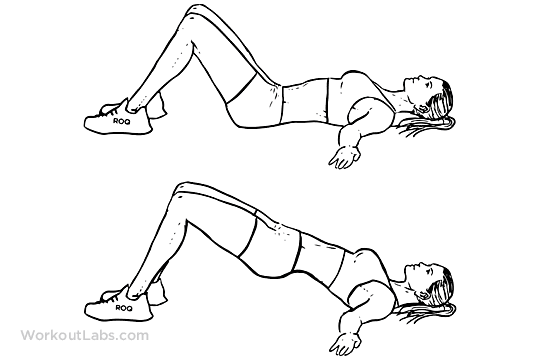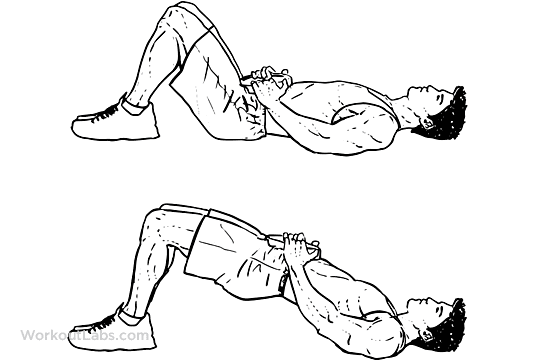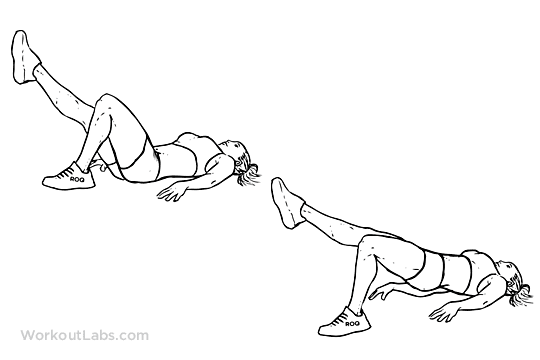The glute bridge, or glute bridge, is a dynamic exercise that can be performed in multiple variations, both bodyweight and overloaded.
The main target as the name implies are the buttocks (active above all for maintaining the position), with a sensitive involvement of all the extensor muscles of the hip (hamstring, semitendinosus and semimebranosus) and of the core.
Glute bridge correct execution
Below we see how a glute bridge repetition is performed.
- The starting position for the "classic" version is supine with the back of the neck resting on the ground, the arms open palms towards the ground, the knees bent and the heels close to the buttocks distant from each other about the width of the pelvis.
- By contracting the abdomen, lift the pelvis off the ground by extending the hip, until the pelvis is in line with the torso and the femur (be careful not to go further, risking dangerously arching the back).
- Maintain the position for 3 seconds (in this phase we have the main work of the buttock).
- Slowly return to the starting position by resting the lumbar area and following the sacral one, without hitting the floor.

Performing the repetitions required in the series, typically you can work with reps series (for example 3 x 15) or with timed series (for example by inserting the glute bridge within an interval training circuit).
Common mistakes when performing the Glute bridge
In itself, the glute bridge is a fairly simple exercise that is often given even to novices due to its easy execution. However, especially in the canonical version, you need to pay attention to a couple of details:
- Avoid arching the back in the hip extension phase: once the buttock is activated, and the femur and torso form a straight line through the pelvis, stop the extension to avoid overloading the lower back.
- During the descent phase, while you are flexing the hip, avoid making a too abrupt movement with the risk of hitting the floor.
- Keep the shoulders on the ground and the nape resting on the ground, without involving the cervical tract in the exercise.
Some variants of the Glute bridge
1. With overload
The exercise is presented in the exact same mechanics, but with the use of an overload such as a disc for the barbell or the same rod of a loaded barbell resting on the pelvis. In this case it is advisable to use the arms to keep the overload in place.

2. With difference in height
The exercise follows the same mechanics of the classic version, with the difference that in this case the feet do not rest on the ground but on a rise such as a step, a step or a park bench.
The difficulty increases due to the fact that the path to complete hip extension is longer and the weight is distributed more heavily.
3. With TRX (suspended)
The start is in the supine position with the shoulders on the ground and the arms open as in the classic version, but the heels are inside the stirrups of the TRX. The condition is similar to the previous case, with an additional difficulty due to the unstable support of the TRX, which forces us to further stabilization work.
4. Con Fit Ball
An even more complex variant of the suspension version, with a similar start and feet resting on a fit ball. In this case, in addition to the stabilization work, it will be necessary to have a great perception and an excellent balance to perform the series correctly.
5. One leg

This variant is applicable to all the previous cases, with the substantial difference that the support of the lower limbs becomes monopodalic. Personally I find this exercise particularly interesting for all combat sports and martial arts where front kicks are foreseen (typically performed with the push of the hip). Particular attention goes to the version on fitball, where the one leg version requires special preparation, achieved through gradual steps.
Conclusion
I find the glute bridge an exercise in itself simple in the basic version, suitable for all those who approach the gym for the first time, not very burdensome and able to be performed even for those who do not have an excellent level of training.
However, in addition to its target for what concerns the involvement of the buttock, the bridge for the buttocks turns out to be very interesting for application to sports where hip extension is a fundamental mechanism: an excellent exercise to keep in mind for your circuits!


























